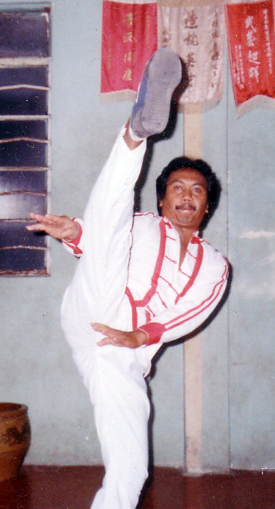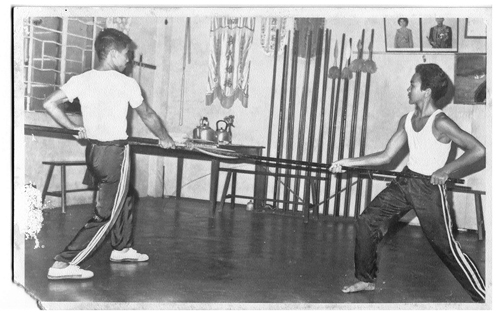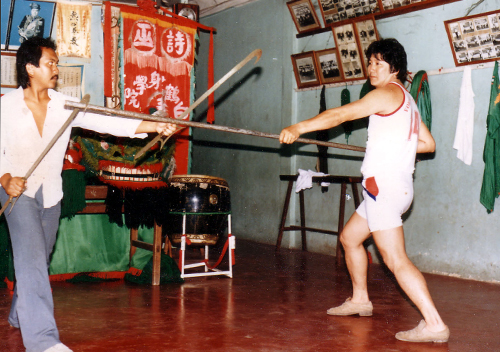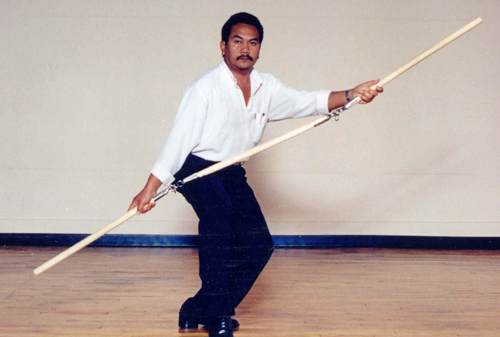 Fujian White Crane kung fu, though in some respects a rare martial arts style, is well-known for its fierce hand techniques. It is also believed to have influenced the development of Okinawan karate. There are many stories of its origins, but most agree that it was created in the late eighteenth century by a slight woman named Fang Chi-Niang. As a girl, she was trained in the martial arts by her father, who learned his kung fu at the Southern Shaolin Temple at Nine Lotus Mountain, Ching Chiang district of China's (modern-day) Fujian province. One day, while Fang Chi-Niang was trying to shoo an obstinate crane away from some drying grain, the noble bird easily deflected all her blows. Amazed, she then practiced her fighting skills every day with the obliging crane, until she had internalized its techniques.
Fujian White Crane kung fu, though in some respects a rare martial arts style, is well-known for its fierce hand techniques. It is also believed to have influenced the development of Okinawan karate. There are many stories of its origins, but most agree that it was created in the late eighteenth century by a slight woman named Fang Chi-Niang. As a girl, she was trained in the martial arts by her father, who learned his kung fu at the Southern Shaolin Temple at Nine Lotus Mountain, Ching Chiang district of China's (modern-day) Fujian province. One day, while Fang Chi-Niang was trying to shoo an obstinate crane away from some drying grain, the noble bird easily deflected all her blows. Amazed, she then practiced her fighting skills every day with the obliging crane, until she had internalized its techniques.
The Flying Crane system is characterized by swift turning and sidestepping, followed by devastating combinations of simultaneous defense and attack. Traditionally, it places a special focus on hand training in order to make use of the fung ying chuan (phoenix eye fist) and the biao so (spear hand) in attacks on vulnerable areas of the body. It is also a comprehensive style, incorporating a great many weapons, always with practical considerations in mind. It is a fighting style, not meant for sport or demonstration. In these characteristics one can see the influence of the style's founder, who was motivated to find ways that would allow even a smaller fighter to defeat a much bigger opponent.
Grandmaster Lee Joo-Chian is the fourth-generation inheritor of the Flying Crane branch of Fujian White Crane kung fu , which originated in southern China in the late 18th century. He traces his kung fu lineage through his father, Lee Kiang-Ke, and his grandfather, Lee Mah-Saw, to his great-grandfather, Lee Fah-Sieng, who was himself taught by the founder of the style, Fang Chi-Niang.
Grandmaster Lee teaches Flying Crane privately in Sibu, Malaysia. He recently opened a new school/traditional Chinese medical store in Mukkha, east Malaysia. In North America, Flying Crane has been taught for the last twenty years by Sifu Lorne Bernard at his White Crane Kung Fu Academy in Montreal. In an effort to encourage the spread of this rare, traditional kung fu system in North America, Grandmaster Lee visits the White Crane Academy every few years, which is where the following interview took place.

LE: When did you start to study kung fu, and what was the training like?
LJC: I started learning kung fu from my father when I was seven years old, in Malaysia. Though there were many students, at that time we hadn't officially registered the school, so we trained at my father's house.
Our training was traditional and was very hard from the start, with long and hard sessions every day, six days a week. To learn just the first form, the basic djuan shen (turning exercises), we had to train six months, before going on to the second move. The first session was from 4:30 in the morning to 5:30;; then we would go to school;; and at night we trained about four hours, from 7 PM to 11 PM.
LE: Did you do other conditioning?
LJC: No. In Malaysia, because it's so hot, we didn't need to warm up; we would just show up and start training.
LE: Is it still like that when you teach? Do you still make students start with 6 months of djuan shen stance and turning training?
LJC: Yes, it is the same way. When you finish the first six months, we check, and if you're ready, you progress to the next move.
LE: Many kung fu schools in North America have adopted levels in their training programs, including Sifu Bernard at his White Crane school in Montreal. Do you have different levels at your school in Malaysia?
LJC: No, not really. Our kung fu brothers learn five years, ten years, fifteen years, up to twenty years; if there's a measurement it's based more on time and achievement than levels.
LE: So, you decide to teach a new move to a student when you think he is ready?
LJC: Well, only a student can really know how hard he has trained and what is best for him. But generally we keep track of how long they have trained, and at a certain point give a small test; and if they perform well enough, we teach in a manner appropriate to their proven achievement.
LE: What distinguishes Fujian White Crane from other kung fu styles?
LJC: This is a big question! For me, well, we cannot say one style is the very best, or we are the special one. For kung fu, it's always the same thing: it's up to you how much you train and what kind of a student you are, and up to your teacher to teach as well as he can, and as well as you deserve. Only if you train and learn and are taught the best, will you be the best.
LE: What distinguishes Flying Crane from other White Crane schools, like Eating Crane, for example?
LJC: Fang Chi-Niang taught four kinds of White Crane techniques: Flying Crane (Fei He), Eating Crane (Shi He) Screaming Crane (Ming He) and Sleeping Crane (Jan He or Su He). Some students would focus on one style, others would focus on another. My family, they learned the Flying Crane style. What distinguishes our style is that we focus on being fast, strong, and hard: this is our White Crane.

LE: To a novice, there does not appear to be a lot of wrestling or ground work in Flying Crane. Can you explain why?
LJC: We do have the di tang chuan (Ground Skill Chuan) at high levels. For the lower levels, we don't focus on these skills. White Crane kung fu is focused on real fighting, not competitions or sport. We try to teach beginners that, in a real fight, if you fall on the ground, you are in big trouble and you might get killed; so, we do have the di tang chuan, but it is for the higher level, when they have already learned how to stay on their feet. Also, our ground work is not the same as Jiu Jitsu, for example. We focus on leg kicks, breaking the leg, that kind of thing, so it's ground fighting, but not what many people might imagine - like the scissors, dog style, very advanced leg sweeps, and, as I said, breaking the leg. It's not wrestling.
LE: Is there qigong in White Crane?
LJC: Yes, we have the qigong in White Crane. If you learn kung fu but don't have the qigong, how will you do kung fu? We use qigong to develop our power, like jing li (hard striking power). When we punch, we want to use our qi to bring our power through to our fingers. If you don't have qi, how can you have power in the fingers?
LE: And is there anything special about the qigong that you teach that is especially different from other approaches to qigong?
LJC: Ah, no, but it must be remembered that within qigong traditions, there are many different forms of practice. Sometimes we sit, sometimes we stand; sometimes we do it the hard or external way, or wai chi kung (external qigong), so qigong comes from inside; but we also do it the soft or internal way, nei kung (internal qigong). Also, we do yen fa (eye work), training our eyes at the same time as we do our qigong.
LE: And how do you train the eyes?
LJC: When we train qigong, it is in the morning, from 4:00 to 4:30; that is when we bring the morning's air into our body, and bring the dirty air out. At that time the sun has just come up, and is not very strong, so we train our eyes by looking at the sun; and when the sun is strong, we stop, and then turn to look at the trees, because we want to see the green colors, to help our eyes.
LE: And do you look at different leaves on the tree?
LJC: No. Only the green color.
LE: And of course qigong is also for training your breathing? When you're fighting White Crane style, how do you breathe?
LJC: First you bring in the air through your nose, then you throw out your power and punch; then you let the air out your mouth, and relax.
LE: Is there chin na (seize and control) in White Crane? Is there anything special about White Crane chin na?
LJC: Yes, in White Crane kung fu, I would say 90% of what we do has something to do with chin na. Chin na is there even in the basics. When you finish the form, and then learn the applications, we teach you how to do the chin na. So even if the junior student can't see it, chin na is implied in the forms and even the basic moves. In a fight, the Flying Crane fighter is always using or looking to use chin na, though it may be in a very subtle way; they are always touching or sensing the opponent, if possible, always.

LE: What weapons are used in White Crane? Are there any special White Crane weapons?
LJC: We have every kind of weapon. There are in fact more than 18 weapons.
LE: And with so many weapons, do you, when a student is good enough, decide what specific weapons he learns?
LJC: First a student must study empty-handed for two to three years, and then we teach the staff chi sing guen fa (seven star staff ). From there the student may move on to other weapons.
LE: What is the last weapon that you teach?
LJC: Well, sometimes the student, maybe he's a big guy, and then we teach him the heavy weapons. The small guy, you give him a heavy weapon, he says, I want to learn, but how can I hold it! So we look at the student's body to see if he is best suited to a heavy or a light weapon, and we teach him accordingly.
LE: Are there any weapons that you won't teach, or that you keep very close, because it's too dangerous?
LJC: Yes. Chains are very dangerous, and often it's just not practical to teach some weapons in the confined space of a school.
LE: Are there many students in your school? Is Flying Crane alive in Malaysia?
LJC: Right now there are not that many students in my school, because in Malaysia people are always looking for jobs; so, you have a good student, but after maybe two to three years, then they move to another city, or another country.
LE: Do you know if there are many people doing White Crane or Flying Crane in China?
LJC: I'm not sure; I think there are not a lot of people there who know the right kind of teaching.
LE: Do you think the tradition of Flying Crane will continue to the next generation, in the next 50 years?
LJC: Maybe. I'm the fourth generation in my family to teach Flying Crane, but whether my son or my grandkids will want to teach, I don't know. But now that Flying Crane has come to Canada, I think maybe, maybe we have a chance!
About
Len Epp :
![]() Len Epp is a writer who has studied Fujian White Crane kung fu for over two years with Sifu Lorne Bernard in Montreal, Quebec. Previously, Len studied WTF Tae Kwon Do for three years with Grandmaster Kee S. Ha in Saskatoon, Saskatchewan. For more information on the Flying Crane style, please see Sifu Bernard's website: .
Len Epp is a writer who has studied Fujian White Crane kung fu for over two years with Sifu Lorne Bernard in Montreal, Quebec. Previously, Len studied WTF Tae Kwon Do for three years with Grandmaster Kee S. Ha in Saskatoon, Saskatchewan. For more information on the Flying Crane style, please see Sifu Bernard's website: .
![]() Print Friendly Version of This Article
Print Friendly Version of This Article
















